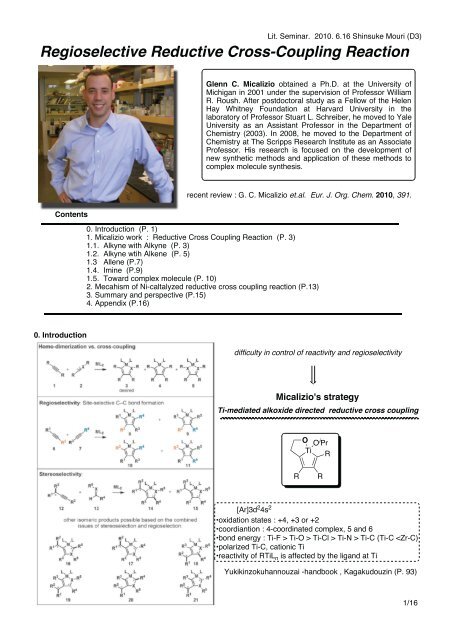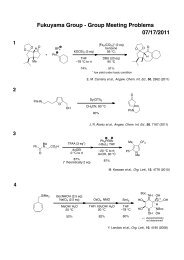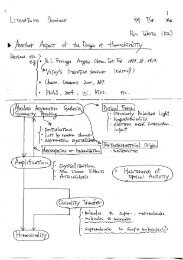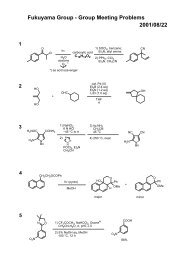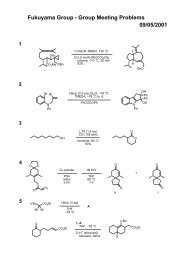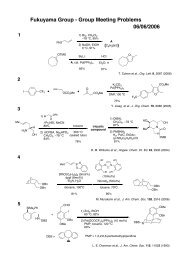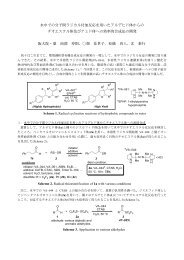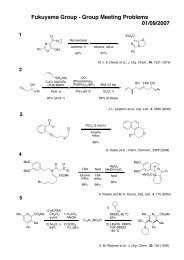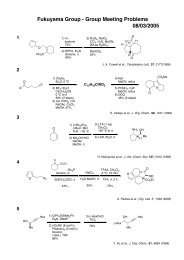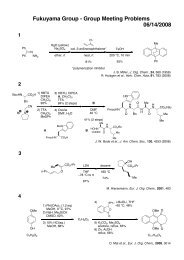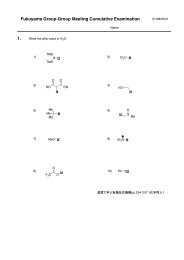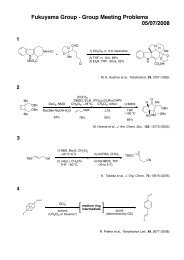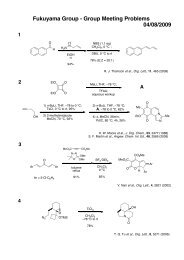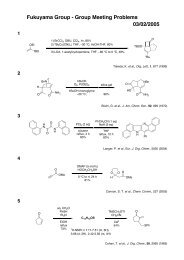Regioselective Reductive Cross-Coupling Reaction
Regioselective Reductive Cross-Coupling Reaction
Regioselective Reductive Cross-Coupling Reaction
You also want an ePaper? Increase the reach of your titles
YUMPU automatically turns print PDFs into web optimized ePapers that Google loves.
Lit. Seminar. 2010. 6.16 Shinsuke Mouri (D3)<br />
<strong>Regioselective</strong> <strong>Reductive</strong> <strong>Cross</strong>-<strong>Coupling</strong> <strong>Reaction</strong><br />
Contents<br />
0. Introduction<br />
Glenn C. Micalizio obtained a Ph.D. at the University of<br />
Michigan in 2001 under the supervision of Professor William<br />
R. Roush. After postdoctoral study as a Fellow of the Helen<br />
Hay Whitney Foundation at Harvard University in the<br />
laboratory of Professor Stuart L. Schreiber, he moved to Yale<br />
University as an Assistant Professor in the Department of<br />
Chemistry (2003). In 2008, he moved to the Department of<br />
Chemistry at The Scripps Research Institute as an Associate<br />
Professor. His research is focused on the development of<br />
new synthetic methods and application of these methods to<br />
complex molecule synthesis.<br />
recent review : G. C. Micalizio et.al. Eur. J. Org. Chem. 2010, 391.<br />
0. Introduction (P. 1)<br />
1. Micalizio work : <strong>Reductive</strong> <strong>Cross</strong> <strong>Coupling</strong> <strong>Reaction</strong> (P. 3)<br />
1.1. Alkyne with Alkyne (P. 3)<br />
1.2. Alkyne wtih Alkene (P. 5)<br />
1.3 Allene (P.7)<br />
1.4. Imine (P.9)<br />
1.5. Toward complex molecule (P. 10)<br />
2. Mecahism of Ni-caltalyzed reductive cross coupling reaction (P.13)<br />
3. Summary and perspective (P.15)<br />
4. Appendix (P.16)<br />
difficulty in control of reactivity and regioselectivity<br />
Micalizio's strategy<br />
Ti-mediated alkoxide directed reductive cross coupling<br />
R<br />
O OiPr Ti<br />
R<br />
[Ar]3d 2 4s 2<br />
•oxidation states : +4, +3 or +2<br />
•coordiantion : 4-coordinated complex, 5 and 6<br />
•bond energy : Ti-F > Ti-O > Ti-Cl > Ti-N > Ti-C (Ti-C
Why did Micalizio focus attention on Ti-mediated strategy?<br />
1. The ability of Ti alkoxide to undergo rapid and reversible ligand exchange.<br />
paste<br />
mechanism of katsuki sharpless epoxidation in<br />
Strategic Applications of Named <strong>Reaction</strong>s in Organic Chemistry (Kagakudouzin)<br />
2. Cp 2 Ti-π complex are known to participate reductive cross coupling.<br />
Sharpless et. al. J. Am. Chem. Soc. 1991, 113, 106.<br />
Katuski T. et. al. Org. React. 1996 ,48, 1.<br />
Bercaw et. al. J. Am. Chem. Soc. 1983, 105, 1136.<br />
Sato. et. al Chem. Rev. 2000, 100, 2835<br />
3. Ti alkoxide could be employed to acess similar reactivity seen with Cp2Ti-π comples (Kulinkovich, Sato)<br />
Kulinkovich et. al. Zh. Org. Khim. 1989, 25, 2244.<br />
the cost of stoichiometric Ti(OiPr) 4 is significantly less than known catalytic systems based on Ni, Rh, Ir or Ru.<br />
2/16
Alkyne + Alkyne<br />
Class I<br />
26 28 27<br />
Micalizio et. al. J. Org. Chem. 2009, 74, 7211.<br />
•O-protected alkyne gave products with moderate rr.<br />
3/16
Class II<br />
Micalizio et. al. J.Am. Chem. Soc .2006 128, 2764.<br />
Substrate scope is limited based on<br />
factors influencing reactivity and resioselectivity.<br />
R 1<br />
Ti(O i Pr) 4<br />
R 2<br />
-78 ºC to -50 ºC<br />
2 h<br />
i PrMgCl<br />
R 1<br />
R 2<br />
Ti(O i Pr) 2<br />
Sato, F. et. al.<br />
Tetrahedron Lett. 1995, 36, 3203.<br />
Ti(O i Pr) 2<br />
Ti(O i Pr) 2<br />
D 2O<br />
R 1<br />
R 2<br />
D<br />
D<br />
up to 100%<br />
Z :E = >99: 1<br />
the tetherd alkoxide plays a central role<br />
in determing regio selection. Jin Kun Cha et. al. J. Am. Chem. Soc. 1996, 118, 4198. 4/16
1.2 Alkyne with Alkene Micalizio et. al. Angew Chem. 2007. 119, 1462.<br />
Micalizio et. al. J. Am. Chem. Soc. 2007, 129, 15112.<br />
allylic alcohol case<br />
OH<br />
+<br />
OPMB<br />
PMBO<br />
65%<br />
PMBO<br />
OPMB<br />
alkyne (1.0 equiv), ClTi(Oi-Pr) 3, PhMe, C 5H 9MgCl, -78 to -35 ºC,<br />
then recool to -78 ºC add Li-alkoxide of allylic alcohol (1.0 equiv)<br />
(-78 to 0 ºC).<br />
• via formal [3,3]-rearrangement route<br />
5/16
6/16
1.3 Allen<br />
1.3.1 allene+ alkyne<br />
Micalizio et. al. Chem. Commun. 2007, 4531.<br />
OH<br />
Me<br />
•<br />
+<br />
OPMB<br />
PMBO<br />
OH<br />
Me<br />
74%<br />
OPMB<br />
OPMB<br />
alkyne (1.4 eq.), Ti(O i -Pr) 4 (2.1 eq.), c-C 5H 9MgCl (4.2 eq.),<br />
PhMe (-78 ºC to -30 ºC), cool to -78 ºC then add allenyl<br />
alkoxide (1 eq.), (-78 ºC to 0 ºC).<br />
1.3.2 allene+ imine<br />
iPr OH + Cl<br />
•<br />
Micalizio et. al. Synlett, 2008, 735.<br />
nPr N<br />
Cl<br />
n Pr<br />
NH<br />
iPr 63%, E/Z = >20:1<br />
Typical reaction conditions: imine (1.0 equiv), ClTi(Oi-Pr) 3<br />
(1.25 equiv), c-C 5H 9MgCl (2.5 equiv), Et 2O (-78 ºC to -40<br />
ºC), then add allenyl alkoxide (3-4 equiv, -40 ºC to 0 ºC).<br />
Micalizio et. al. Tetrahedron 2008, 68, 3437.<br />
7/16
8/16
1.4. Imine<br />
(Micalizio et.al. Angew. Chem. Int. Ed. 2007, 46, 391.) aza-Pauson Khand-like annulation reaction for the<br />
synthesis of tetrasubstituted γ-lactams<br />
(Micalizio et.al. Chem Commun. 2010, 46, 3336.)<br />
carbometalation process is irreversible.<br />
9/16
Toward complex molecule<br />
Micalizio et. al. J. Am. Chem .Soc. 2008, 130, 16870<br />
ca. 50%<br />
a) MeC(MgBr)CH 2 , MeC(OMe) 3, EtCOOH (cat), reflux<br />
(Micalizio et.al. J. Am. Chem. Soc. 2009, 48, 3648.)<br />
(d) Imine (2.0 equiv), Ti(O i -Pr) 4 (3.0 equiv),<br />
c-C 5H 9MgCl (6.0 equiv), 8 (1 equiv), Et 2O.<br />
(b) HCl(aq), THF.<br />
•This empirical model does not yet address the number of<br />
ligands presenton the metal center in the transition state.<br />
•Others have suggested ate complexes as reactive<br />
intermediates in the Kulinkovich reaction.<br />
O<br />
R OR<br />
+ Ti(O i Pr) 4<br />
n PrMgBr<br />
Ti (Oi -<br />
Pr) 4<br />
R OR<br />
octahedral ate complex<br />
Kulinkovich et. al. Eur. J. Org. Chem. 2007, 2121.<br />
O<br />
10/16
Micalizo et. al. Nat. Chem. DOI: 10.1038/NCHEM.665<br />
1)<strong>Reaction</strong> conditions for cross-coupling: vinylsilane, ClTi(Oi-Pr) 3, c-C 5H 9MgCl, Et 2O (-78 to -50 ºC), then add lithium alkoxide of<br />
vinylcyclopropane(–70 ºC to roomtemperature over 3 h). Oxidation conditions: TBHP, H 2O, CsOH.H 2O, TBAF, DMF, 70 ºC.<br />
2)Oxidation conditions: KF, KHCO 3, H 2O 2, MeOH, THF. CH 2Cl 2, Sm[Hg], THF, (85%, dr= 20:1). PDC, 4-Å molecular sieves,<br />
CH 2Cl 2 (91%), then L-Selectride, THF (76% of desired isomer, dr=6:1).<br />
11/16
(a)ClTi(Oi-Pr) 3, c-C 5H 9MgCl, 35 (-78 to 30 ºC), PhMe, then lithium alkoxide of 34 in Et 2O (-70 ºC to room<br />
temperature over 3 h)<br />
(b)TBAF, THF<br />
(c)ClTi(Oi-Pr) 3, c-C5H9MgCl, alkyne (-78 to -30 ºC), PhMe, then lithium alkoxide of the vinylcyclopropane in Et 2O<br />
(-70 ºC to room temperature over 3 h);<br />
(d) HF.pyr, CH 3CN, CH 2Cl 2;<br />
(e) PDC, DMF, H2O.<br />
Yields reported are over the three-step sequence (c-e) and are adjusted based on the quantity of recovered<br />
starting material (vinylcyclopropane). Isolated yields for each reaction sequence are 38% (equation (2)), 36%<br />
(equation (3)) and 23% (equation (4)) over the three-step process (corresponding to average yields of 60-70% per<br />
step).<br />
Micalizio et. al. J. Am. Chem. Soc. 2009, 131, 1392.<br />
O<br />
OH<br />
total synthesis<br />
OH<br />
Me Me Me<br />
OAc<br />
Phorbasin C<br />
Me<br />
Micalizio et. al. Angew. Chem. Int. Ed. 2008, 47, 4005.<br />
MeO<br />
Me<br />
H<br />
H<br />
Me<br />
O<br />
NH 2<br />
OMe<br />
Me<br />
H<br />
O<br />
H<br />
N<br />
OMe<br />
O<br />
Me<br />
O<br />
H<br />
O<br />
Macbecin I<br />
Me<br />
12/16
2. Mechanism of Ni-catalyzed reductive cross coupling reaction<br />
R 1 R 2 +<br />
H<br />
O<br />
R 3<br />
+ BEt 3<br />
Ni(0) catalyst<br />
H + /H 2O<br />
J. Montgomery et. al.<br />
J. Am. Chem. Soc. 2007, 129, 9568.<br />
J. Krische et. al.<br />
J. Am. Chem. Soc. 2007, 129, 8432.<br />
F. Jamison, et. al.<br />
J. Am. Chem. Soc. 2004, 126, 15342.<br />
R 1<br />
R 2<br />
OBEt 2<br />
Jamison and Houk et. al. J. Am. Chem. Soc. 2009, 131, 6654<br />
(a) oxidative cyclization of alkyne and aldehyde to form a metallacycle intermediate, followed by<br />
transmetalation of the reductant and subsequent reductive elimination of the product<br />
(b) a similar mechanism but with the metal bonded to the reductant in the oxidative cyclization<br />
(c) oxidative addition of the reductant to the metal and subsequent insertion of the two π components<br />
(d) oxidative addition to one π component (alkyne or aldehyde) and subsequent insertion of the second<br />
component.<br />
R 3<br />
13/16
R 1<br />
3<br />
R 1<br />
R 2<br />
L<br />
Ni<br />
L<br />
L<br />
Ni<br />
R 2<br />
4 H<br />
R 1<br />
O<br />
R 3<br />
R 2<br />
11<br />
OBEt 2<br />
R 3<br />
acetylene<br />
oxidative<br />
cyclization<br />
TS1-A<br />
Path A<br />
R 1<br />
5<br />
+<br />
R 2<br />
R 1<br />
L<br />
Ni<br />
1<br />
H<br />
R 2<br />
O<br />
R 3<br />
+<br />
R 1<br />
BEt 3<br />
H<br />
O<br />
2<br />
R 2<br />
L<br />
Ni<br />
6<br />
Path B<br />
R 3<br />
O<br />
R 3<br />
R 1<br />
ethylene<br />
BEt 3<br />
R 2<br />
oxidative<br />
cyclization<br />
TB1-B<br />
L<br />
Ni<br />
H<br />
7<br />
O<br />
R 3<br />
R 1<br />
R 1<br />
BEt 3<br />
R 2<br />
L<br />
Ni<br />
L<br />
Ni<br />
8<br />
O<br />
R 3<br />
BEt 3<br />
R 1<br />
R OBEt<br />
10 2<br />
2<br />
R3 L Et<br />
Ni<br />
O<br />
R 2<br />
9<br />
transmetalation<br />
(alkyl migration)<br />
TS2<br />
R 3<br />
BHEt 2<br />
β-hydrogen<br />
elimination and<br />
reductive<br />
elimination<br />
TS3<br />
14/16
3. Summary and Perspective<br />
Micalizio demonstrated new type of reductive cross coupling based on the Ti mediated alkoxide directed<br />
strategy. This system is applicable to many type of reductive cross coupling and also Micalizio is also<br />
successful in to complex molecule. Further if possible....<br />
1) catalytic<br />
2) mechanism - ligand number and effect on Ti (transition state )<br />
(Micalizio et.al. Angew. Chem. Int. Ed. 2009, 48, 3648.)<br />
15/16
4. Appendix<br />
Jamison and Houk et. al. J. Am. Chem. Soc. 2010, 132, 2050.<br />
16/16


